
Newsletter of the Shell Club of Sydney
NSW Branch, The Malacological Society of Australasia Limited ACN 067 894 848
Limpets
Patty Jansen
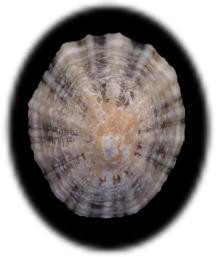
Patella vulgata L., 1758 the type of the genus, from England
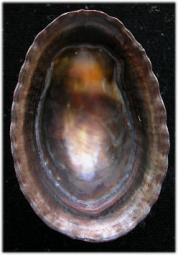
Nacella concinna (Strebel, 1908), a specimen from Antarctica
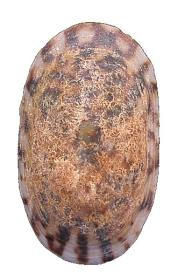
Lottia alveus (Conrad, 1831), the species that died out in the Atlantic. This specimen is from the NW coast of Canada
We are all familiar with the limpet shape: a cap-like, uncoiled shell, that lives in the intertidal zone, generally associated with the genus Patella. They are so common that we give them little thought. In this article we will debunk a few myths about limpets
The genus Patella does not occur in Australia. All too true. All Australian Patellid limpets, and there are only four, belong to the genus Scutellastra: S. flexuosa, S. chapmani. S. peronii, S. laticostata.
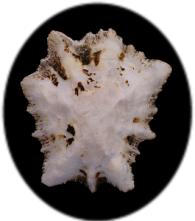
Scutellastra flexuosa (Quoy & Gaimard, 1834) a species that occurs throughout the Indo-Pacific, and also in Northern Australia. This specimen is from Indonesia
And even the genus Scutellastra may yet end up in a different family. True Patellid limpets of the genus Patella occur mainly in Europe and down the West coast of Africa. Scutellastra occurs in the Indo-Pacific from the Central West American coast to South Africa. In fact, South Africa is the only place in the world where all four Patellid limpet genera occur. The other two genera are Helcion and Cymbula (C. compressa and C. miniata). Whereas Patella has more species, Scutellastra can claim to include the largest species in the family: S. mexicana (W. Mexico), S. tabularis (South Africa) and S. kermadecensis (Kermadec Islands N. of New Zealand)
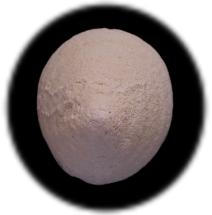
Acmaea mitra Rathke in Eschscholz, 1833 from Canada and Western USA
Cellana tramoserica and C. solida are not in the Patellidae
No, they're not. They're in the Nacellidae. Other Australian species include C. conciliata (Qld.), C. radiata (tropical Pacific including N. Australia), C. turbator (Qld.) and C. analogica (Lord Howe Island).
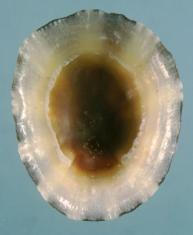
Cellana conciliata Iredale, 1940, from Magnetic Island, Queensland
The family Nacellidae includes only the genera Cellana and Nacella. Except for a few species such as C. radiata, C. grata, C. testudinaria, C. toreuma and C. nigrolineata which occur in Japan and adjacent Indo-Pacific, the Nacellidae are exclusively distributed in the southern hemisphere. In fact, the further south, the better it gets. Both New Zealand and it's subantarctic Islands, and Tierra del Fuego (the very tip of South America at about 57o South) are very rich in species. Some occur in Antarctica
None of the smaller Australian limpets belong in the Acmaeidae
No, they don't. In fact, the family Acmaeidae has been reduced in size to include only a few species in two subfamilies. One subfamily contains the North American Acmaea mitra, a white shell that was found to be so different from the other previous 'Acmaeidae' that keeping them in the same family did not seem justified.
The other subfamily, Pectinodontinae lives in very deep water. All those shells are white, too.
The small Australian limpets, which are all coloured, belong in the family Lottiidae. The family Lottiidae has over 150 species worldwide. The main centre of distribution is America, especially the West coast, with smaller groups in Australia, New Zealand and Japan. There are a few species in the Atlantic. There are also two subfamilies: Lottiinae and Patelloidinae. Australian species belong in both subfamilies.
The limpet shape is not limited to members of the families Patellidae, Nacellidae, Acmaeidae and Lottiidae
No, it is not. The limpet shape can be found across a wide range of families. Lepetidae, Lepetellidae, Cocculinidae are related families with limpet shells. The Haliotidae and Fissurellidae display a modified limpet shape. In the Fissurellidae, some species have a reduced shell, i.e. the animal is too big for it's shell, such as Scutus anatinus.
The South American Fissurellid genus Buchanania does not have a shell at all. Other families to have developed limpet-shaped members are the Neritidae, Calyptraeidae, Capulidae, Eulimidae, Muricidae, Amathinidae, Siphonariidae.
Limpets are not limited to the intertidal and shallow subtidal zone
No, they're not. Whilst all members of the familiar limpets live in shallow water, a few families related to Patellidae, such as the Lepetidae, Lepetellidae and Cocculinidae live in very deep water, some are associated with hydrothermal vents
Limpets are vulnerable to exploitation and environmental change. Yes, they are. They are also the most studied
gastropod group. Yet the only two cases of a mollusc becoming almost extinct through human influence involve limpet species. The Lottiid Lottia alveus went extinct in the N E coast of America, when the seagrass it lives on disappeared from the habitat. Thankfully, the species lives on in the Pacific. The Patellid Scutellastra mexicana is being overfished by poor fishermen in W. Mexico to such an extent that it's very survival is threatened. Everyone I have asked about this species has told me they either haven't found any recently, or found only small specimens.
"Red Abalones" from Iceland
Ulrich Knodel
Haliotis rufescens Swainson 1822
Brief description of the species and a new abalone farm.
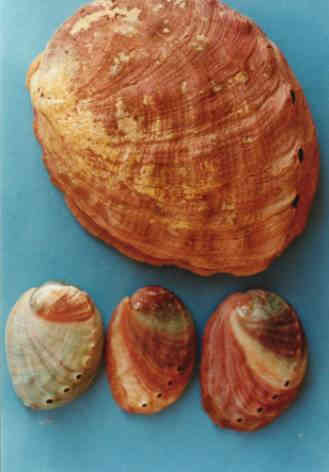
Haliotis rufescens Swainson 1822 Farmed in Iceland
Top: Adult, California
Bottom Right: Juvenile, California.
Bottom centre: Juvenile, Iceland.
Bottom Right: Juvenile, California.
Members of the Haliotis Linne 1758 (Haliotidae) are wide spread in different habitats of the world seas: from tropical reefs to the cold waters off Alaska, from the tide level to the deep sea, with limited ranges or widely distributed.
Recently I received a parcel with some shells labelled as "Haliotis rufescens, Iceland!" Knowing this is a species from off western North America, I thought this to be an error but the enclosed letter and info gave me the explanation: the shells of my parcel are in fact from Iceland.
The shells are not from "off" Iceland but from -to say it so- "on" Iceland. The shells were harvested in a farm in the country. In a small town near Reykjavik (the capital city of Iceland) around ten years ago an abalone farm was erected. Juvenile "Red Abalones" were brought in from the original habitat to Iceland to be harvested there in large tanks; the meat used as commercial seafood, the shells, collectors items.
Clean water is pumped from a well in 200 metres depth into the tanks. Mixed with naturally boiling volcanic water of Iceland a perfect environment was made. Two kinds of kelp from off Iceland were used to feed the abalone; Laminaria digitata and Palmaria palmata. When feeding on the first kelp the abalones produce a greenish shell; when feeding on the second the shells are reddish. This too is visible in
juveniles in their original Californian habitat: therefore different algaes as food can produce different coloured shells.
Haliotis rufescens Swainson 1822 is the largest species in the genus Haliotis; usually it grows up to 200-250mm although specimens up to 300mm are known. The so-called "Red Abalone" has a round- oval shell, which in adults, is always more or less uniform pale red but in juveniles is often greenish, due to their diet.
This species inhabits the coasts of the Californian shell province, between South Oregon and Baja. The shell lives typically on the hard bottom in water with temperatures ranging between 6 and 16 0C. Juveniles appear to prefer somewhat warmer water.
Following these temperatures, the shells of the southern part of its range usually live in depths of more than 20 metres. In San Luis Obispo County (CA) the depth is reported to be 30 metres and deeper. In the northern part of its range where the water is colder, it lives from the low tide level to a depth of approximately 15 metres.
Adults feed on macro algae: the "Giant Kelp" is the favourite diet in the southern part of its range. In the northern part the shells feed on "Bull kelp" and in the shallower water, the "Feather boa kelp".
The animal of a large shell is impressive; it makes a good "steak". The epipodeum is black; sometimes with grey stripes. The tentacles are always a deep black. This species has been used from early times as food.
In recent times it has been necessary to restrict the "abalone fishing" at the Californian (s.l.) coast. Five specimens per person per day with a minimum size of 17.5 cm, is the regulation to avoid
over fishing. It appears that the regulations are too late this once common to abundant species is now uncommon to rare in some locations. Not only has mankind endangered this and other species but natural events, such as El Nino, have also had their effect on disturbing the abalone population.
It is no wonder then that for several years, farms have come into existence to produce this delicacy. Usually these farms are in the abalone regions from where they harvest the local species for example the "Awabis" in Japan, the "Perlemoen" in South Africa and "abalones" in western America. However Iceland has no Haliotis at or on the coast. It is to my knowledge, the first and only farm which produces foreign abalones at an "abalone less" coast. Both the diet and the water are strange for the abalone but it appears to work.
In a study comparing the "Red and the Green abalone"; Haliotis fulgens Philippi 1845 in a farm, the red was much more sensible. In a cultivation system tank on the land (Oxnard, California) the shells were grown for 11 months. Only 73 per cent of the "Red" shells survived as opposed to 96 per cent of the "Green" shells.
The hypothetical size at the beginning was 35mm and at the end of the study it was 56.9mm. The total weight of each red abalone was 2467g, green was 2544g. The mortality rate in Iceland is said to be very low and the abalones grow rather fast. The first shells are reported to be over 200mm in size. The "red" abalone appears to feel very well in this handmade habitat although the water and food is not from the original habitat. So we shellers too can in future collect "Abalones from Iceland" and who knows, perhaps even some day, cones and cowries??
Turbinellidae Pt. 18
By Ulrich Knodel
Vasum (Vasum) rhinoceros (Gmelin 1791)
As Voluta rhinoceros Gmelin 1791
Syn Turbinella rhinoceros GMELIN Lamarck 1822
The "Rhinoceros Vase Shell" is reported to be common in its habitat but nevertheless, the restricted range of this species makes it not easy to obtain for the collector and the prices for the shell are somewhat higher than one would expect for a "common" species.
This species is restricted to East Africa: Kenya, Tanzania and Zanzibar are the reported localities. The type locality, "New Guinea" reported by Gmelin was an error but Reeve in 1847, reported the locality of the type specimens correctly as Zanzibar.
The "Rhinoceros" is seen as a more or less direct descendant of Vasum aquitanicum from the lower Miocene. Other shells closely related to this line are Vasum turbinellus, V. tubiferum, V. armatum and V. ceramicum. Compared with the latter species the "Rhinoceros" is a rather smooth shell, ( for a Vasum) and a variable one.
The shell of V. rhinoceros is solid and heavy; the shape varies from turbinate to sub-fusiform. Several rows of knobs are present on the outer shell; often the knobs are developed to form spines. The knobs may be very strong or weak, the spines well or poorly developed and blunt or sharp.
The colouration of the outer shell is usually cream with light to very dark brown mottlings in endless variations. The columella is "brownish"; ranging from shadows of very light brown to large dark brown blotches. In some specimens the whole columella has a purplish shine. I have not found a relationship between the outer and inner colouration: light coloured shells may have a dark brown columella and dark coloured shells may have a weakly coloured columella. A few colonies exist (the only locality reported is "Zanzibar") with a so called golden or yellow form. Here the colouration of the outer shell is a more or less uniform cream-yellow with no or very weak brownish mottlings and the columella is a uniform cream with a yellow or golden shine.
The shell ranges in size from 40 - 80 mm. I have three larger specimens (85, 87 and 89mm); Abbott (1959) reported one about 92mm.
This species lives in colonies in shallow water on rocky, sandy and weedy bottom just inside fringing coral reefs. Abbott (1959) reported it too …. " rarely dredged on a sand and rubble bottom to a depth of 48 feet..".
The shells in my collection are all from depths of 2-6 metres; one was collected alive (with operculum) in 10 metres on sand.
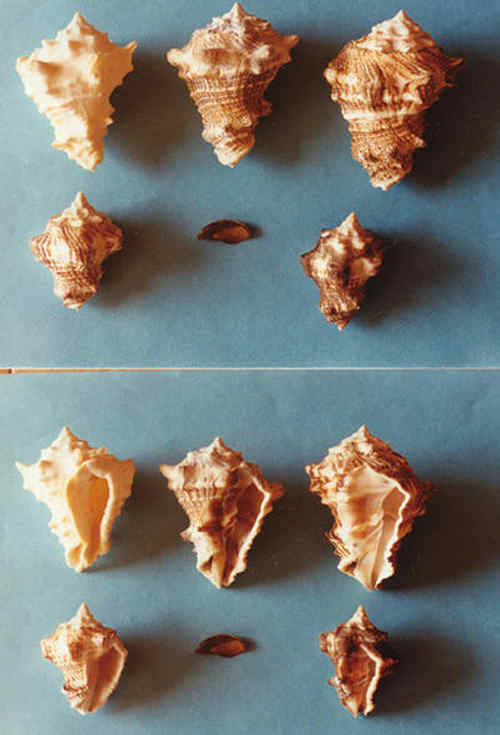
V. rhinoceros
Upper Left: yellow form, 3 m depth
Upper middle: 10 m on sand with operculum
Upper right: 4m on coral reef
Lower Left: light colour, 4 m on sand
Lower Middle: operculum of shell above
Lower right: dark colour, 3m on corals
2001-2002 President's report
Patty Jansen
Another year has passed and it's time for another report. Our club has continued successful monthly meetings. The attendance has been steady, with about 15-20 people at each meeting. The Ryde-Eastwood Leagues club has continued to provide the satisfactory room for free.
The August meeting Chris Barnes showed some slides of shells, mostly Cowries, he has collected at Little Bay. Chris' finds continue to be amazing which all shows that there is no substitute for visiting an area frequently.
In September, I did not attend the meeting due to family commitments, but I hear Michael ran a very successful auction of some old material he was donated from the Kay Rutland collection. Kay, once an active member, has now moved into a nursing home and was so kind to donate her collection to the club.
John Franklin, Steve Dean and Adrian Browne very successfully ran the October Shell Show. Even though some of the 'larger' collectors were not in attendance, the material on show was exceptionally good.
In November we had a prominent visitor, Daniel Geiger from the USA, author of many papers and a book on Haliotidae, now working on Scissurellidae at the Australian Museum. Dan gave an excellent talk on Haliotidae, and some of us had many questions for him. At this time we also had the massive subscription increases and new publication schedule of Molluscan Research to discuss. Most of the members were in support of the changes, and indicated they would renew their membership, but we did ask the secretary to write a letter to the National Council in support of a cheaper non-professional membership.
The Christmas Party, held early December at the restaurant in the club, which provides our regular meeting venue, was a great success, with more than 30 people turning up. It was a very jolly affair, with raffles (won by Michael) and live music.
In January I was in New Zealand for a holiday and their shell show, but Maureen did a good job chairing the meeting, and I hear attendance was unusually good for January.
In February, Ron Moylan showed us some of his videos taken during his reef trips over the past few years. It was great putting some faces to names, especially as most of these people would be in Brisbane the next month.
In March we cancelled the meeting, as most of us were in Brisbane for the shell show. Members who attended at least part of the show were: Maureen and Noel Anderson, Ashley Miskelly, John Dunkerley, Ron and Marina Moylan, Steve Dean, Adrian Browne, Catherine Kindt, John Franklin (who had to jump through multiple hoops, including losing his ticket in the Ansett collapse, to get there). Not many of us entered in the competitive sections, but Maureen did and managed to take third in Shell of the Show. Some of us swapped shells, some sold sells, but all of us bought more shells than we got rid of. It seems that the very undemocratic selection process for the fifth national shell show (there was no delegates meeting and Adelaide came to the show with their leaflets already prepared) robbed us of the chance of having another show in Sydney in 2004, so it looks like we will have to go for the 2006 show. That is an awful long way off yet, but it seems if we want this to happen we better get into action.
In April Patty talked about limpets, and brought in a selection of them, including the largest limpet in the world, Scutellastra mexicana
In May Jack Hannan gave a talk about the weather and how it might influence collecting. This was very interesting.
In early December, we had a field trip to Norah Head. It was a nice day, but nothing extraordinary was found. Another field trip to Little Bay in March was abandoned due to bad weather. Chris and Patty met each other at Little Bay two weeks later, and found some real interesting things, including Cypraea helveola (dead) and Conus coronatus live.
Members had some interesting trips. Maureen and Noel visited the Yeppoon and Townsville Shell Shows. Ron Moylan was also at Yeppoon and John Dunkerley at Townsville. Patty visited the New Zealand Shell Show and brought many shells from New Zealand. Ron went of a few more diving trips to the reef and brought back some great material.
We have gained two new members this year. We like to officially welcome Catherine Kindt and Sandra Montague and hope they will enjoy their membership of our club.
In the club, our committee has again worked to keep things running. We must all realise that without volunteers to take positions, there will be no club. So we must thank Chris and Karen Barnes for their role as secretaries. Karen has retired from the position with the impending birth of son Andrew. Recently, she has again been visiting meetings again, babe in arms. The cake roster, instated when Karen could no longer bake due to kitchen renovations, has worked well. John Franklin has done an excellent job as treasurer and also in his liaison with the Ryde Eastwood Leagues club, for which we are very grateful, as this has not always been easy. Steve Dean had continued to produce an excellent newsletter, and Maureen Anderson has done very well as the Raffle Lady. In fact income from our raffles has never been so high. Our present team has agreed to stay on for another year. Thanks must also go to those who simply turn up at meetings, who bring their shells, and other things to share. Let the next year also be a good one.
|








